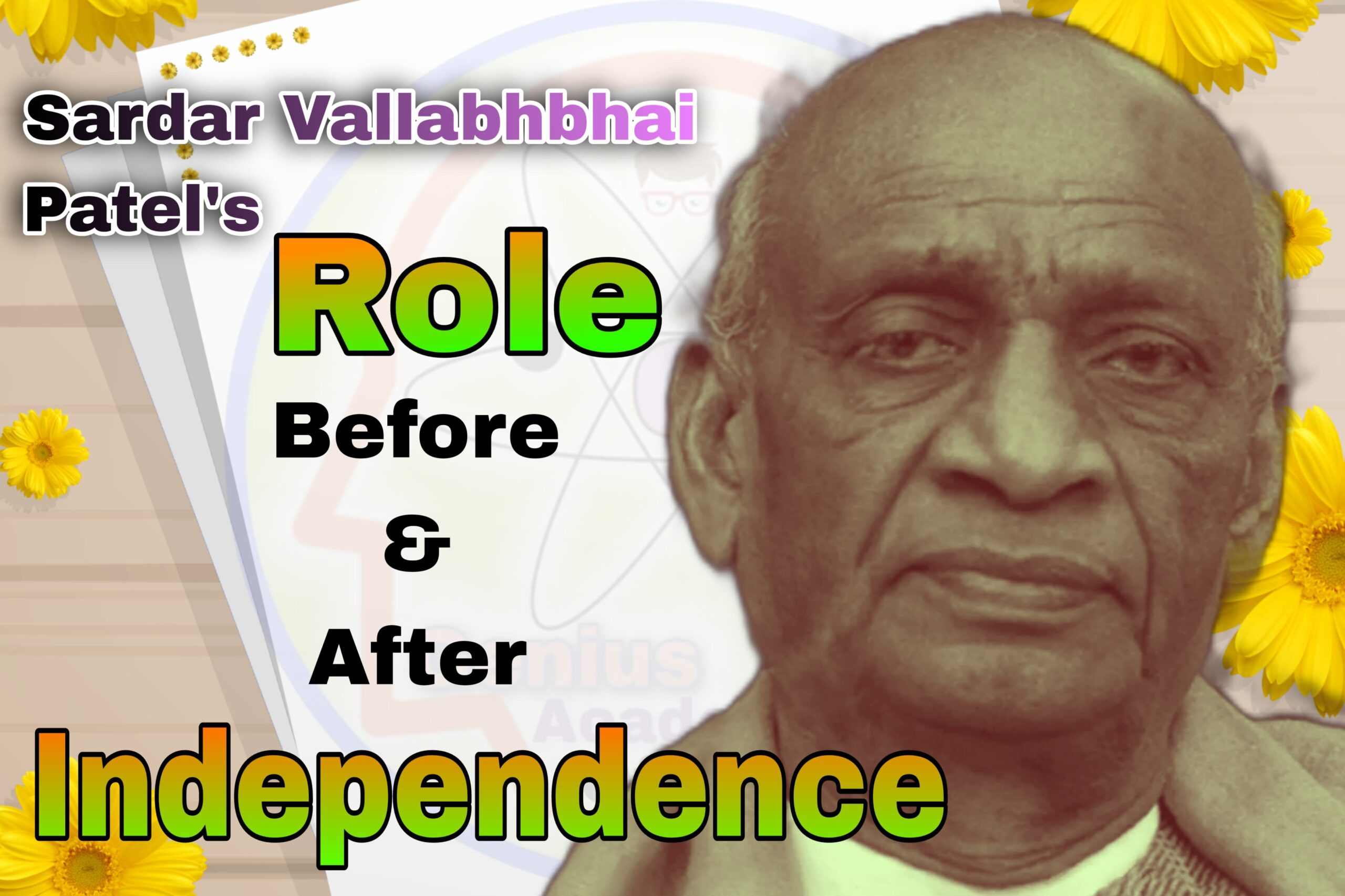
Role of Sardar Patel in India’s Freedom Struggle and Nation-Building
Sardar Vallabhbhai Patel, fondly known as the “Iron Man of India,” was instrumental in both the struggle for independence and in shaping a unified India after independence. Known for his uncompromising dedication, leadership, and vision, Patel not only played a significant role in the freedom movement but also laid the groundwork for a strong, cohesive nation post-1947. His contributions both during the freedom struggle and in post-independence India, are:—
Early Role of Sardar Patel in the Indian Freedom Struggle
Patel’s political journey began in 1917, marking the start of a lifelong commitment to India’s liberation from British rule. His association with Mahatma Gandhi proved influential, and Patel became an essential leader in the Indian National Congress.
- Secretary of Gujarat Sabha (1917)
In 1917, Patel was elected as the Secretary of the Gujarat Sabha, a branch of the Indian National Congress. This position allowed him to effectively coordinate regional activities against British policies, particularly in Gujarat. Patel emerged as a prominent regional leader who could galvanize local support for the Congress’s causes. - Kheda No-Tax Campaign (1918)
One of Patel’s earliest and most celebrated campaigns was the “No Tax Campaign” in Kheda (Kaira) in 1918. Following devastating floods that destroyed crops in the Kheda region, the British government refused to waive land taxes. Patel led a movement urging farmers not to pay taxes until their economic situation improved. This campaign not only showcased his organizational abilities but also brought him the title “Sardar,” a testament to his leadership among the people of Gujarat. - Salt Satyagraha (1930)
During the famous Salt Satyagraha of 1930, Patel took on the responsibility of leading the movement in Gujarat when Gandhi was arrested. He was also imprisoned for his role in the movement, further solidifying his reputation as a stalwart of the freedom struggle. His dedication to the cause inspired millions, especially in rural areas, to rise against the British salt monopoly. - Non-Cooperation and Civil Disobedience Movements
Patel was a staunch supporter of Gandhi’s non-cooperation movement, which encouraged Indians to boycott British institutions and goods. In the 1920s, he became a crucial figure in the Congress, advocating for complete independence from colonial rule. His persuasive speeches and grassroots work in Gujarat brought thousands of people into the fold of the movement. - Gandhi-Irwin Pact (1931)
Patel was released from prison in 1931 after the Gandhi-Irwin Pact, an agreement between Mahatma Gandhi and the then Viceroy of India, Lord Irwin. This pact marked a temporary truce between the British government and Indian nationalists, leading to the release of political prisoners. Patel’s release allowed him to further his political work and strengthen the national movement. - Quit India Movement (1942)
Patel’s commitment to the freedom movement was especially evident during the Quit India Movement in 1942. While some leaders were uncertain about the timing, Patel remained steadfast in his support for Gandhi’s call for the British to “Quit India.” He traveled across the country, delivering powerful speeches and mobilizing people. Despite intense repression, Patel’s unshaken commitment helped keep the momentum of the movement alive.
Role of Sardar Patel in Post-Independence Nation-Building
Upon India’s independence in 1947, Patel took on the daunting task of unifying a fragmented country. His contributions as the first Deputy Prime Minister and Home Minister of India were crucial in setting up the administrative, territorial, and social foundations of modern India.
- Integration of Princely States
Post-independence, Patel was tasked with integrating over 562 princely states into the Indian Union. This was no small feat, as many princely states were resistant to joining a unified India. Patel’s diplomacy, combined with his resolute stance, convinced all but a few states—Hyderabad, Junagarh, and Jammu & Kashmir—to join the Indian Dominion. His successful unification efforts led to the India we see today. - Resolution of the Kashmir Conflict
Patel played a key role in addressing the 1947 conflict in Kashmir. When Pakistan attempted to invade Kashmir, Patel acted decisively. While Jawaharlal Nehru managed the foreign and diplomatic aspects of the issue, Patel focused on the military response to secure the region. His efforts in organizing a strong defense laid the groundwork for future strategies regarding Kashmir. - Establishment of the Indian Administrative Service (IAS) and Indian Police Service (IPS)
Recognizing the need for an efficient and unbiased administrative framework, Patel was instrumental in establishing the Indian Administrative Service (IAS) and the Indian Police Service (IPS). These institutions have since been the backbone of India’s governance, ensuring stability and continuity. Patel’s vision of a professional civil service helped strengthen India’s democratic structure. - Restoration of the Somnath Temple
Patel took a personal interest in restoring the Somnath Temple in Gujarat, an iconic symbol of Indian cultural heritage. The project represented his dedication not only to political unity but also to preserving India’s cultural identity. Although he passed away before the temple’s completion, his efforts reflected his belief in a strong, unified nation, proud of its heritage. - Management of Refugee Crisis
The partition of India in 1947 resulted in massive displacement and communal violence. Patel organized numerous refugee camps in Punjab, Delhi, and later in West Bengal to accommodate the influx of refugees. His efficient handling of this humanitarian crisis helped stabilize the nation in one of its most tumultuous periods. - Contribution to Economic and Social Policies
Patel’s post-independence work extended to policy-making aimed at economic and social development. He advocated for land reforms, promoted industrialization, and supported initiatives for self-sufficiency. Patel’s policies were pragmatic and focused on nation-building, aiming to create a stable foundation for India’s growth.
Conclusion
Patel’s emphasis on unity and integrity still resonates in India’s administrative and governance structures. His vision for a unified India, strong in its diversity, is a testament to his wisdom and foresight. The efforts he made toward building a resilient India continue to inspire generations and are a cornerstone of the Indian Republic.
Through his relentless dedication, Sardar Vallabhbhai Patel laid the foundations for a democratic, inclusive, and culturally rich nation. His legacy, preserved in various institutions, policies, and monuments, including the Statue of Unity, stands as a reminder of his invaluable contributions.
Role of Sardar Patel
Role of Sardar Patel
Role of Sardar Patel
Role of Sardar Patel
